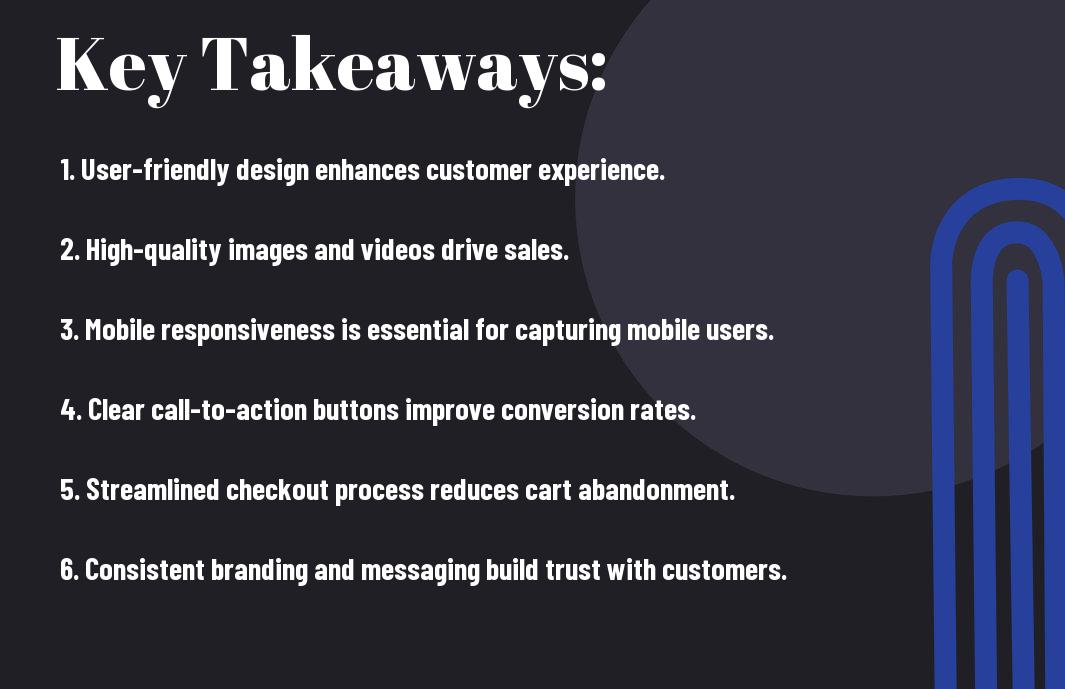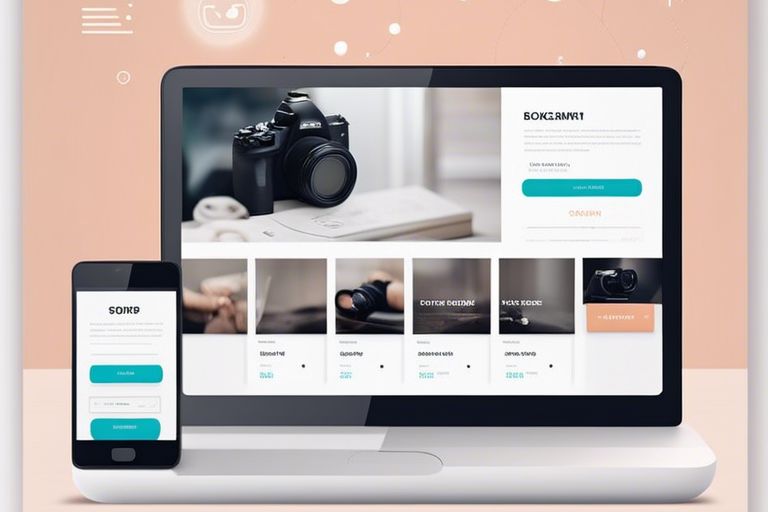Indubitably, your e-commerce website design is a crucial factor in driving sales and converting visitors into customers. In today’s competitive online market, it is essential to utilize your website’s design to its fullest potential in order to stand out and succeed. The layout, navigation, visual appeal, and user experience all play a significant role in influencing consumer behavior and ultimately determining whether they make a purchase or leave your site. In this blog post, we will explore key strategies and techniques to effectively leverage website design to boost your e-commerce sales and ensure the success of your online business. Whether you are a seasoned e-commerce entrepreneur or just starting out, these insights will help you optimize your website design for maximum sales impact.
Key Takeaways:
- User-First Approach: Prioritize user experience and design a website that is easy to navigate, visually appealing, and optimized for mobile devices.
- Clear Call-to-Actions: Use strategically placed and compelling CTAs to guide users toward making a purchase, signing up for newsletters, or completing other desired actions.
- Optimized Product Pages: Ensure that product pages are informative, visually appealing, and include high-quality images, detailed descriptions, customer reviews, and easy access to purchase options.
- Seamless Checkout Process: Streamline the checkout process by minimizing steps, offering multiple payment options, and providing clear shipping and return policies to reduce cart abandonment.
- Data-Driven Optimization: Use analytics tools to track user behavior, identify areas for improvement, and continually optimize website design and functionality to drive better e-commerce sales results.

Understanding User Experience (UX)
Some of the most successful e-commerce businesses in the world have one thing in common: they understand the importance of user experience (UX) design. Your website’s UX is the overall experience a person has when using your website, including aspects such as usability, accessibility, and overall satisfaction. It is crucial for boosting e-commerce sales as it directly impacts your visitors’ behavior and their likelihood to make a purchase.
Principles of Effective UX Design
When it comes to effective UX design, there are several principles that you should keep in mind to ensure that your website is optimized for an exceptional user experience. It’s important to prioritize usability, ensuring that your website is easy to navigate and understand. Additionally, visual appeal plays a significant role in UX and can greatly impact how users perceive your brand. Moreover, responsive design is non-negotiable in today’s mobile-driven world, ensuring your website looks and functions seamlessly across all devices. Paying attention to these principles will help you create a website that not only looks good but also drives e-commerce sales.
Analyzing User Behavior to Inform Design Choices
By analyzing the behavior of your website visitors, you can gain valuable insights that will inform your design choices and ultimately lead to increased e-commerce sales. Utilize analytics tools to track user behavior, such as click-through rates, time spent on-page, and popular product interactions. This data will provide you with a deeper understanding of how visitors are interacting with your website and where improvements can be made. By identifying pain points and addressing them through design, you can create a smoother, more enjoyable experience for your users, ultimately leading to higher conversion rates and increased sales.
Visual Elements That Convert Visitors
After visitors land on your e-commerce website, the way it looks can significantly impact their decision to stay and make a purchase. Visual elements play a crucial role in catching and retaining the attention of potential customers. Here are some key visual elements that can help convert visitors into paying customers on your e-commerce site.
The Psychology of Color in Web Design
When designing your e-commerce website, the colors you choose can make a substantial impact on your visitors. Different colors can evoke emotional reactions and influence purchasing decisions. For example, red can create a sense of urgency and is often associated with clearance sales or special offers. Blue is often associated with trust and security and can be effective in building customer confidence. It’s essential to consider the psychological impact of colors when selecting the color scheme for your website, as it can influence how visitors perceive your brand and products.
Incorporating High-Quality Images and Videos
High-quality images and videos can significantly enhance the shopping experience on your e-commerce site. When customers can see detailed images and videos of your products, they feel more confident about making a purchase. Make sure your images are clear, high resolution, and showcase the products from different angles. Including product videos can also provide customers with a better understanding of the product and its features. Visual storytelling through images and videos can help you convey the value of your products and create a more immersive shopping experience for your visitors.
Website Performance Optimization
Despite the importance of having a visually appealing e-commerce website, 7 Ecommerce UX Design Strategies That Increase Sales emphasize the need for website performance optimization to enhance the overall user experience and increase conversion rates. Your website’s performance directly impacts your e-commerce sales, so it’s crucial to focus on optimization. Here are a few key strategies to improve your website’s performance for greater profitability.
Enhancing Site Speed for Improved User Satisfaction
When it comes to e-commerce, every second counts. Slow loading times can lead to high bounce rates and abandoned shopping carts. To ensure an optimal user experience, you need to prioritize site speed. This can be achieved through various methods such as minimizing HTTP requests, implementing browser caching, and optimizing images and scripts. By streamlining your website’s performance, you can reduce bounce rates and keep potential customers engaged throughout the buying process.
Responsive Design for Mobile Users
As more and more people are using their mobile devices for online shopping, having a responsive design is essential for reaching and engaging with potential customers. A responsive website design ensures that your site looks and functions seamlessly across all devices, providing convenience and consistency for your users. By prioritizing mobile optimization, you can capture a wider audience and increase your sales potential across all platforms.
Building Trust with Your Audience
For a successful e-commerce website, building trust with your audience is crucial. One way to do this is to ensure that your website design is professional and user-friendly. A well-designed website not only reflects positively on your brand but also makes it easier for visitors to navigate and find what they’re looking for. To further enhance your website’s credibility, you can leverage professional e-commerce website development to elevate your online sales.
Importance of Secure Payment Gateways
When it comes to e-commerce, the security of payment gateways is non-negotiable. Your customers need to feel confident that their personal and financial information is safe when making a purchase on your website. By implementing a secure payment gateway, you not only protect your customers’ sensitive data but also build trust and confidence in your brand. Make sure to highlight the security measures you have in place to reassure your customers that their transactions are safe and secure.
Utilizing Customer Testimonials and Reviews
Another effective way to build trust with your audience is by showcasing customer testimonials and reviews. When potential customers see positive feedback from others who have purchased from you, it validates the quality of your products or services and instills confidence in your brand. Encourage satisfied customers to leave reviews and testimonials, and prominently display them on your website to provide social proof of your credibility and reliability.

Conclusion
Taking this into account, leveraging website design is crucial for boosting e-commerce sales. By implementing a user-friendly layout, optimizing for mobile devices, and incorporating high-quality visuals, you can create a seamless shopping experience for your customers. Additionally, offering multiple payment options, clear call-to-action buttons, and streamlined checkout processes will encourage customers to make purchases. Remember to regularly analyze your website traffic and conversion rates to make necessary adjustments and continually improve the overall performance of your e-commerce site. By prioritizing website design and user experience, you can significantly increase your e-commerce sales and ultimately grow your business.
FAQ
Q: What role does website design play in boosting e-commerce sales?
A: Website design plays a crucial role in boosting e-commerce sales as it directly impacts the user experience, trust, and credibility of the online store. A well-designed website can lead to increased conversions and customer satisfaction.
Q: What are the key elements of website design that can optimize e-commerce sales?
A: Key elements include intuitive navigation, mobile responsiveness, clear calls-to-action, high-quality visuals, fast loading times, and a secure checkout process. These factors help streamline the user journey and encourage visitors to make purchases.
Q: How can the use of effective visuals and imagery impact e-commerce sales?
A: Effective visuals and imagery can enhance the overall aesthetic appeal of the website, showcase products in an appealing manner, and create a strong brand identity. High-quality visuals can capture the attention of potential customers and entice them to explore product offerings further.
Q: What role does mobile responsiveness play in driving e-commerce sales?
A: With the growing number of consumers using mobile devices for online shopping, mobile responsiveness is crucial for e-commerce success. A website that is optimized for mobile devices ensures a seamless shopping experience, increases accessibility, and can lead to higher conversion rates.
Q: How can website design influence customer trust and loyalty in e-commerce?
A: A well-designed website that conveys professionalism, provides a secure and transparent shopping experience, and offers reliable customer support can build trust and loyalty among customers. A cohesive and visually appealing design can also help create a positive brand image and foster long-term customer relationships.
